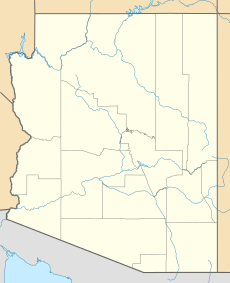Church Rock (Arizona) facts for kids
Quick facts for kids Church Rock |
|
|---|---|

Southwest aspect
|
|
| Highest point | |
| Elevation | 5,862 ft (1,787 m) NGVD 29 |
| Prominence | 472 ft (144 m) |
| Geography | |
| Location | Navajo County, Arizona, U.S. |
| Topo map | USGS Church Rock |
| Geology | |
| Age of rock | Oligocene |
| Type of rock | Volcanic breccia |
Church Rock is a tall, natural rock formation in Navajo County, Arizona. It stands near the entrance of Church Rock Valley. This amazing rock reaches an elevation of 5,862 feet (1,787 m). You can find it about 7.5 miles (12.1 km) east of Kayenta.
Church Rock is on land belonging to the Navajo Nation. You can easily spot it from Highway 160. It rises about 400 feet (122 meters) above the valley floor.
Church Rock is actually an ancient volcanic plug. Imagine a volcano that was active millions of years ago. When it stopped erupting, the hot, melted rock (magma) inside its vent cooled down and hardened. Over a very long time, the softer rock around this hardened core wore away. This process, called erosion, left behind the harder volcanic plug. Church Rock is part of the Navajo Volcanic Field. This area has many interesting rocks that formed about 30 million years ago during a time called the Oligocene epoch.
History
Exploring the Old Spanish Trail
Church Rock was first named Artenesales de Piedra by a Mexican explorer. This name means "Sculpted Rock." The explorer, Antonio Armijo, gave it this name between 1829 and 1830. He was on an expedition to find a trade route. This route would connect Santa Fe de Nuevo México (in present-day New Mexico) with Alta California (in present-day California).
This important trade route became known as the Old Spanish Trail. Specifically, it was part of the Armijo Route.
Gallery
Climate
Weather at Church Rock
The best times to visit Church Rock are during spring and fall. The weather is usually very pleasant then. This area has a semi-arid climate. This means it has cold winters and hot summers.
In summer, temperatures often go above 90 °F (32 °C). It rarely gets hotter than 100 °F (38 °C). Summer nights are cool and comfortable. Temperatures drop quickly after the sun sets. Winters are cold, but daytime temperatures are usually above freezing. It's rare for winter temperatures to drop below 0 °F (−18 °C). This desert climate gets less than 10 inches (250 millimeters) of rain each year. Snowfall in winter is usually light.








